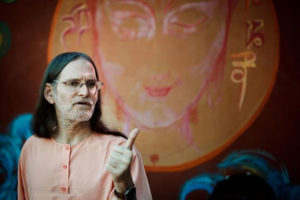 I would like to continue this series with a little more background and history to set the stage and context for our study of the Bhagavad Gita. Throughout the ages people, probably throughout the planet, maybe possibly other planets, went deep into the mind, transcended the mind, and found a true reality. In India this was mostly passed on by word of mouth from Guru to disciple. Eventually, after probably hundreds of years, somebody started writing these things down. And then someone collected them, and that collection became known as the Vedas.
I would like to continue this series with a little more background and history to set the stage and context for our study of the Bhagavad Gita. Throughout the ages people, probably throughout the planet, maybe possibly other planets, went deep into the mind, transcended the mind, and found a true reality. In India this was mostly passed on by word of mouth from Guru to disciple. Eventually, after probably hundreds of years, somebody started writing these things down. And then someone collected them, and that collection became known as the Vedas.
The Vedas are divided into two sections—the karma-kanda, which is the action section, and the jnana-kanda, which is the knowledge or wisdom section. The karma-kanda deals with how to lead a secure, pleasurable life, but mostly with an eye to reaching a higher level, which we can call heaven. The jnana-kanda is working with the knowledge, wisdom and spirituality. The culture that grew up around these teachings took place originally in North India, the Indus Valley. And they called it sanatana dharma, the eternal truth, the eternal way. Later, when the British occupation occurred, since they were in the Indus Valley they called the people the “Hindus,” and that’s where the term came from. But the true essence of Vedic and Yoga teaching is really sanatana dharma. It’s very broad thinking. You can believe God had form. If you believed God was with form, you could choose the form—whichever form you were most drawn to. You could also believe God had no form and was an all-pervading underlying Consciousness. There was no need to believe in a “Creator God” in sanatana dharma.
The essence of sanatana dharma, or the essence of the Vedas, is called Vedanta—the end of the Vedas. In Sanskrit, “ve” means “without, “danta” means “teeth.” In other words, when you’re old and gray and can’t chew your food well, that’s when you would study these teachings. But, that’s probably too late, so it’s best not to understand Vedanta in that way! You need to have some energy to practice Vedanta. The essence of Vedanta in 700 verses is called the Bhagavad Gita.
Before the Bhagavad Gita starts, there are nine verses called the Gita Dhyanam, or the meditation on the Gita. These verses are designed to help prepare the mind for the study of the Gita. And to prepare the mind I can think of three things that these verses do:
- They help us to be more focused, concentrated, undistracted, so we put our full attention in the Gita study.
- They help us to humble our ego so that we get more attuned and aligned with Sri Krishna’s teachings.
- They prepare the mind by giving us faith, so that when we’re studying the Gita, we’re studying not just with our head but with our heart.
In The Living Gita, Swami Satchidananda’s commentary on the Gita, he lists just a few of the nine verses of the Gita Dhyanam, which are so inspiring and so I have memorized these:
OM, O Bhagavad Gita, by which Arjuna was illumined by Lord Krishna himself and which was composed of eighteen chapters
within the Mahabharata by the ancient sage Vyasa;
O Divine Mother, Destroyer of rebirth, who showers the nectar of oneness on us;
O Bhagavad Gita, my affectionate Mother, on Thee I meditate.
All the Upanishads are the cows, the milker is the cowherd boy, Krishna;
Arjuna is the calf; people of purified intellect are the drinkers; the milk is the supreme nectar of the Gita,
My salutations to the Lord who is the source of supreme bliss, whose grace makes the mute eloquent and the crippled cross mountains.
There are a few key points these verses highlight:
o The Gita is composed of 18 chapters within the Mahābhārata by the ancient sage Vyāsa…so the Bhagavad Gita is 700 verses from this sacred epic poem.
o It says, O Bhagavad Gita, “my affectionate mother, on Thee I meditate.” I like that. The Sanskrit word used is “Amba,” meaning “Divine Mother,” “Affectionate Mother.” This Mother is very patiently lifting Arjuna and us up, elevating us.
o Chapter by chapter, we’re moving further along the spiritual path.
o It also says “O Divine Mother, Destroyer of rebirth, who showers the nectar of oneness on us.” So the Bhagavad Gita showers a nectar of oneness on us. The nectar is that if there’s only oneness, there’s no one and no thing to be afraid of.
I would like to close this article with a quote from Mahatma Gandhi:
“When doubts haunt me, when disappointments stare me in the face and I see not one way of hope on the horizon, I turn to the Bhagavad Gita and find a verse to comfort me and immediately begin to smile in the midst of overwhelming sorrow. Those who meditate on the Gita will derive fresh joy and new meaning from it every day.”
About the Author:
 Swami Asokananda, initiated into monkhood in 1973 by Sri Swami Satchidananda, is the spiritual director of Integral Yoga Institute of New York, co-director of the Integral Yoga Global Network, and one of Integral Yoga’s foremost teachers. He is the primary instructor for the Intermediate and Advanced Hatha Yoga Teacher Trainings offered around the world.
Swami Asokananda, initiated into monkhood in 1973 by Sri Swami Satchidananda, is the spiritual director of Integral Yoga Institute of New York, co-director of the Integral Yoga Global Network, and one of Integral Yoga’s foremost teachers. He is the primary instructor for the Intermediate and Advanced Hatha Yoga Teacher Trainings offered around the world.

